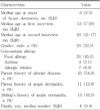Abstract
Purpose
The aim of this study was to longitudinally examine the correlation between the change of atopic dermatitis (AD) severity and the change of quality of life (QOL).
Methods
We assessed AD severity and QOL of patients and their families, by a prospective followed up for at least 12 months. AD severity was assessed, using the scoring of atopic dermatitis (SCORAD) index. A questionnaire based on dermatitis family impact (DFI), infants' dermatologic quality of life (IDQoL) and children's dermatology life quality index (CDLQI) were used to determine QOL.
Results
Seventy-nine AD patients were assessed for total and objective SCORAD and DFI. Among them, 45 patients that were less than 36 months old completed IDQoL and 13 patients that were equal to or more than 36 months old completed CDLQI. Objective SCORAD (oSCORAD) were correlated with DFI (r=0.235), IDQoL (r=0.602) and CDLQI (r=0.589) (P<0.05). At the 2nd interview, median oSCORAD (from 17.4 to 7.8), DFI (from 23.0 to 18.0) and IDQoL (from 9.0 to 6.0) were significantly decreased (P<0.01). The changes of oSCORAD were linearly related with the change of IDQoL (P<0.01), but neither with DFI (P=0.356) nor with CDLQI (P=0.267). Of the 64 patients with decreased oSCORAD, food allergy was accompanied more frequently in those with an increased DFI than those with a decreased DFI (60.7% vs. 27.8%, P<0.01).
Figures and Tables
 | Fig. 1Relationship between the changes in objective SCORAD and Quality of life indexes. SCORAD, scoring of atopic dermatitis; DFI, dermatitis family index; IDQoL, infants' dermatitis quality of life index; CDLQI, children's dermatology life quality index. |
References
1. Aoki T, Fukuzumi T, Adachi J, Endo K, Kojima M. Re-evaluation of skin lesion distribution in atopic dermatitis. Analysis of cases 0 to 9 years of age. Acta Derm Venereol Suppl (Stockh). 1992. 176:19–23.
2. Kay J, Gawkrodger DJ, Mortimer MJ, Jaron AG. The prevalence of childhood atopic eczema in a general population. J Am Acad Dermatol. 1994. 30:35–39.

3. Hong SJ, Ahn KM, Lee SY, Kim KE. The prevalences of asthma and allergic diseases in Korean children. Pediatr Allergy Respir Dis. 2008. 18:15–25. (Korea).

4. Lewis-Jones MS, Finlay AY. The Children's Dermatology Life Quality Index (CDLQI): initial validation and practical use. Br J Dermatol. 1995. 132:942–949.

5. Beattie PE, Lewis-Jones MS. A comparative study of impairment of quality of life in children with skin disease and children with other chronic childhood diseases. Br J Dermatol. 2006. 155:145–151.

6. Su JC, Kemp AS, Varigos GA, Nolan TM. Atopic eczema: its impact on the family and financial cost. Arch Dis Child. 1997. 76:159–162.

7. Ring J, Palos E. Psychosomatic aspects of parent-child relations in atopic eczema in childhood. II. Child-rearing style, the family situation in a drawing test and structured interview. Hautarzt. 1986. 37:609–617.
8. Ho RC, Giam YC, Ng TP, Mak A, Goh D, Zhang MW, et al. The influence of childhood atopic dermatitis on health of mothers, and its impact on Asian families. Pediatr Allergy Immunol. 2010. 21:501–507.

9. Schmitt J, Langan S, Williams HC. European Dermato-Epidemiology Network. What are the best outcome measurements for atopic eczema? A systematic review. J Allergy Clin Immunol. 2007. 120:1389–1398.

10. Severity scoring of atopic dermatitis: the SCORAD index. Consensus Report of the European Task Force on Atopic Dermatitis. Dermatology. 1993. 186:23–31.
11. Charman CR, Venn AJ, Williams HC. The patient-oriented eczema measure: development and initial validation of a new tool for measuring atopic eczema severity from the patients' perspective. Arch Dermatol. 2004. 140:1513–1519.
12. Hanifin JM, Thurston M, Omoto M, Cherill R, Tofte SJ, Graeber M. EASI Evaluator Group. The eczema area and severity index (EASI): assessment of reliability in atopic dermatitis. Exp Dermatol. 2001. 10:11–18.

13. Ben-Gashir MA, Seed PT, Hay RJ. Are quality of family life and disease severity related in childhood atopic dermatitis? J Eur Acad Dermatol Venereol. 2002. 16:455–462.

14. Ben-Gashir MA, Seed PT, Hay RJ. Quality of life and disease severity are correlated in children with atopic dermatitis. Br J Dermatol. 2004. 150:284–290.

15. Lee HJ, Park CO, Lee JH, Lee KH. Life quality assessment among adult patients with atopic dermatitis. Korean J Dermatol. 2007. 45:159–164.
16. Hon KL, Kam WY, Lam MC, Leung TF, Ng PC. CDLQI, SCORAD and NESS: are they correlated? Qual Life Res. 2006. 15:1551–1558.

17. Cho SI, Kim JH, Chung BY, Ahn IS, Kim HO, Park CW, et al. Quality of life in children and adolescents with atopic dermatitis. Korean J Dermatol. 2011. 49:415–421.
18. Shin N, Kim SH, Cho S, Whang KK, Hahm JH. The impact of childhood atopic dermatitis on their families. Korean J Dermatol. 2000. 38:494–499.
19. Park CK, Park CW, Lee CH. Quality of life and the family impact of atopic dermatitis in children. Korean J Dermatol. 2007. 45:429–438.
20. Hanifin JM, Rajka G. Diagnostic features of atopic dermatitis. Acta Derm Venereol (Stockh). 1979. 59:Suppl 92. 44–47.
21. Lawson V, Lewis-Jones MS, Finlay AY, Reid P, Owens RG. The family impact of childhood atopic dermatitis: the Dermatitis Family Impact Questionnaire. Br J Dermatol. 1998. 138:107–113.

22. Lewis-Jones MS, Finlay AY, Dykes PJ. The Infants' Dermatitis Quality of Life Index. Br J Dermatol. 2001. 144:104–110.

23. van Valburg RW, Willemsen MG, Dirven-Meijer PC, Oranje AP, van der Wouden JC, Moed H. Quality of life measurement and its relationship to disease severity in children with atopic dermatitis in general practice. Acta Derm Venereol. 2011. 91:147–151.

24. Gånemo A, Svensson A, Lindberg M, Wahlgren CF. Quality of life in Swedish children with eczema. Acta Derm Venereol. 2007. 87:345–349.

25. Beattie PE, Lewis-Jones MS. An audit of the impact of a consultation with a paediatric dermatology team on quality of life in infants with atopic eczema and their families: further validation of the Infants' Dermatitis Quality of Life Index and Dermatitis Family Impact score. Br J Dermatol. 2006. 155:1249–1255.





 PDF
PDF ePub
ePub Citation
Citation Print
Print






 XML Download
XML Download